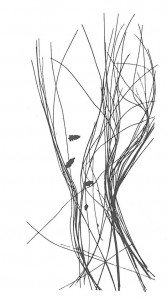To detect lice requires experience, patience and good eyesight. It is important that as many people as possible have this experience – especially in periods with very few lice infestations. The lice should be shown to others; however, respect and consideration of the infected person should be kept in mind.

Lice. If moving lice are spotted, the matter is clear. If only dead lice are found, it must be determined if they died before or after eradication measures have been taken.
Nits. Newly laid nits are placed so close to the scalp, they are almost impossible to see. If they do not come off when stroking the hairs, they are nits. If they slide on the hair, it’s probably dandruff, sebum, dirt, etc.
It can be difficult to see if nits are alive. However, there are some positive signs that they are not:
A. When the lid is missing or loose the nits have hatched.
B. Flat nits.
C. Discolored nits (red or black) are dead.
When the hair grows, the nits, and later the empty nit shells, follow. Scalp hair grows about l cm per month. This is useful information.
First: We know that the nits are laid close to the scalp, and that the average hatching time is about a week. Therefore, the nits that are found more than 4-5 mm away from the scalp must be either hatched or dead.
Secondly: By measuring how far out, the outermost nits are placed; it is possible to get an idea of the duration of the infestation. Whether they are empty or not, nits found 5 cm away from the scalp indicates that the first lice infected the hair 5 months earlier. (In England it has been found out that, in average, the lice are discovered four months after the infestation of British schoolchildren).
Practical detection. Choose to part, brush or comb the hair with a fine-tooth comb. The three methods each have their advantages and disadvantages.
1 Parting the hair. As the main interest is seeing the scalp and the 5 mm of the hair closest to the scalp, this method is reasonable when dealing with long hair. Part the hair with a comb. Hold the part open with your fingers and look closely at the scalp. Do the next parting parallel to the first, 1 cm away and continue like this until you have examined the whole scalp.
2 Brushing the hair. If the hair is not too long, you can brush lice etc. on to a piece of paper. The brushing needs to be hard and from the scalp. Put the contents of the paper into a glass bowl or the like and review it under a microscope with 10 – 25-x magnification. This will contain the animals that – because of high age or illness – cannot hold on to the hair. It will also contain empty skins (which can be hard to distinguish from dead lice). Also look for nits in loose hairs, as well as for lice excrements.
3 Combing with a fine-tooth comb. Lice rarely fall out during usual hairdressing. The combs that are being used as “fine-tooth combs” today are not as fine-toothed as they should be. A fine-tooth comb can be used to detect lice and to eradicate lice. A real fine-tooth comb can catch lice, crush nits and pull out hair with nits. It is made of hard metal or plastic. The distance between the teeth is small and corresponds to the thickness of the scalp hair. A very fine-tooth comb includes a cleaning scraper. Combing the hair is a difficult and sometimes painful eradication method that is best suited for short hair (often, it is a little easier with a bit of conditioner in the hair).The fine-tooth combs cannot compete with modern medicated lice treatments, but can still be useful in detection and in treatment of people who are against the use of poison in the hair.




